
Achieving goals means doing the work that brings success. This includes getting yourself organised on a daily basis by planning your time. When you consciously and intentionally choose how and where you spend your time, you minimise stress that otherwise builds up when you have to rush to get things done at the last minute. To help you plan your time for a highly successful day, I’ve created a beautiful daily planner that you can download and print from my website. And it’s free! Read on for some tips on how to use the planner to make the best investment of your time each day.
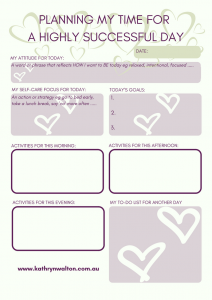
Plan Your Time for a Highly Successful Day
Your planner has been designed to be quick and easy to use. When you invest a couple of minutes each day into planning how you choose to spend your time, the payoffs can be enormous! A little bit of organisation goes a long way. Here are a few tips to get you started with your planner.
Choose an attitude to take you through the day
It’s all well and good that you make an action plan, but it’s even more important to choose an attitude for the day. Visualise yourself selecting and clothing yourself in an attitude each morning, just as you choose which clothes to wear. Writing your attitude down on your planner, right at the very top, will keep it present in all that you do. Here are some examples of attitudes that you might like to choose from (but really, the sky is the limit with choice here!)
- relaxed

- focused
- intentional
- mindful
- gentle
- assertive / firm
- warrior
- action-oriented
- efficient
- patient
Choose a self-care focus for the day
Self-care makes you more resilient and gives you strength. But it can easily get tossed to the side when you’re busy. Don’t be a self-sacrificing martyr – the world needs you to stay strong – so make sure your self-care stays high on your list of priorities. Some examples of self-care that you can incorporate into your day include:
- go to bed at …….. (write down the time you intend to go to bed)
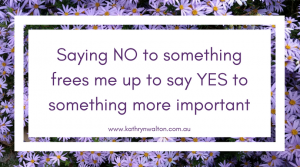
- take my lunch break away from my work
- say ‘no’ more often
- go for a walk
- chat with a friend
- take the time to cook a nutritious meal
- meditate
- read a book for ½ hour
Choose 2 – 3 goals for the day
Don’t be overwhelmed by your to-do list. Be realistic. Choose just 2 or 3 tasks to prioritise for each day. When you achieve your short list of objectives, you’ll feel a sense of accomplishment and motivation. And that’s much better than feeling overwhelmed at the enormity of everything on your ever-expanding to-do list that you haven’t accomplished in the day. Some days my short list of goals or priorities looks like this:
2. be on time for school pick-up
3. have dinner ready by 7pm
Other days I choose goals that require more energy and focus, such as:
1. write and publish a blog post
2. update clinical records
3. research and write new privacy policy
Break the day up into sections
I often refer to this technique as “chunking it down”. When you break the day up into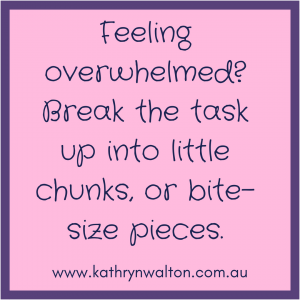 chunks, you’re better able to focus on that one period of time. You work more efficiently and effectively, gain a sense of achievement throughout the day, and feel less overwhelmed by the enormity of what’s on your plate. This type of scheduling can be applied to many different situations including school assignments, boring tasks, housework, meetings and so on. On your planner you can break up the activities you want (or need) to focus on in the morning, afternoon and evening. Here’s an example of what my planner sometimes looks like:
chunks, you’re better able to focus on that one period of time. You work more efficiently and effectively, gain a sense of achievement throughout the day, and feel less overwhelmed by the enormity of what’s on your plate. This type of scheduling can be applied to many different situations including school assignments, boring tasks, housework, meetings and so on. On your planner you can break up the activities you want (or need) to focus on in the morning, afternoon and evening. Here’s an example of what my planner sometimes looks like:
Activities for This Morning
- go for walk
- pay the bills online
- clinical and administration tasks
Activities for This Afternoon
- watch a training video
- get the groceries while my son is at his speech lesson
Activities for This Evening
- reheat leftovers for dinner
- join my online video mentoring group
Keep a list of to-do’s to carry over to another day
At the bottom of your planner there is space for you to keep a list of tasks, activities and other to-do’s that weren’t on your priority list for today. Having them handy here means that if your day has gone smoothly and you have time and energy up your sleeve, you can easily run your eye down this list and select additional tasks to work on. Or, perhaps things haven’t worked out today as expected and you need to reorganise your priorities. This space also enables you to make a record of tasks as you think of them so they don’t get lost in your hazy busy brain! My ‘to-do list for another day’ is quite extensive. I use it like a bank of tasks that I can select my priority goals from each day, and then cross them out as I achieve them!
other to-do’s that weren’t on your priority list for today. Having them handy here means that if your day has gone smoothly and you have time and energy up your sleeve, you can easily run your eye down this list and select additional tasks to work on. Or, perhaps things haven’t worked out today as expected and you need to reorganise your priorities. This space also enables you to make a record of tasks as you think of them so they don’t get lost in your hazy busy brain! My ‘to-do list for another day’ is quite extensive. I use it like a bank of tasks that I can select my priority goals from each day, and then cross them out as I achieve them!
So there you have it! A system to plan your time for a highly successful day. And a reminder to be gentle with yourself when it doesn’t all go to plan. This system is simply a plan – a flexible tool to guide your daily choices and actions. Experiment with the plan to see what works best for you.
Take a Minute for Your Mind
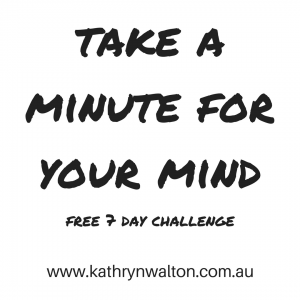 HAVE YOU SIGNED UP FOR MY FREE 7 DAY CHALLENGE “TAKE A MINUTE FOR YOUR MIND”? Available for a limited time only! For more information and to register, go to the OFFERS tab on my website!
HAVE YOU SIGNED UP FOR MY FREE 7 DAY CHALLENGE “TAKE A MINUTE FOR YOUR MIND”? Available for a limited time only! For more information and to register, go to the OFFERS tab on my website!
Discovering mountain biking as life’s ultimate parallel universe in her middle age,  Kathryn Walton shares information and reflections in Daisy Spoke that connect, inspire and self-empower women to make healthy choices for themselves. She integrates her love of physical exercise, family, nature, gardening and creative arts with her professional background in mental health social work to facilitate change with individuals, groups and communities of women who are committed to living life to the full.
Kathryn Walton shares information and reflections in Daisy Spoke that connect, inspire and self-empower women to make healthy choices for themselves. She integrates her love of physical exercise, family, nature, gardening and creative arts with her professional background in mental health social work to facilitate change with individuals, groups and communities of women who are committed to living life to the full.
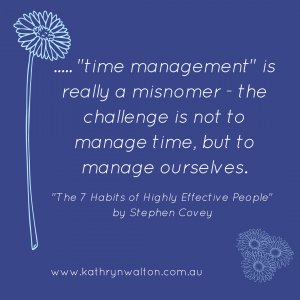
 So first of all, make sure you GET THE BIG ROCKS IN YOUR LIFE FIRST. They are your priorities so take steps to make sure you allow plenty of time and energy for them. Next put in your medium-sized rocks. Your small rocks go in after that and will be able to settle into the spaces between the bigger rocks. You can be more flexible with how they fit into your life. Next comes the sand. These things will be able to flow into the spaces that you have left. If there isn’t time and energy for them right now, that doesn’t matter. When things settle, they’ll have a place in your bucket once again.
So first of all, make sure you GET THE BIG ROCKS IN YOUR LIFE FIRST. They are your priorities so take steps to make sure you allow plenty of time and energy for them. Next put in your medium-sized rocks. Your small rocks go in after that and will be able to settle into the spaces between the bigger rocks. You can be more flexible with how they fit into your life. Next comes the sand. These things will be able to flow into the spaces that you have left. If there isn’t time and energy for them right now, that doesn’t matter. When things settle, they’ll have a place in your bucket once again. 
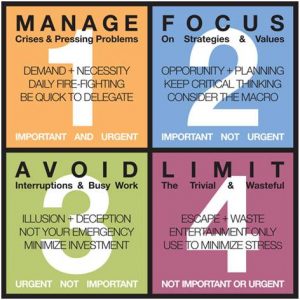

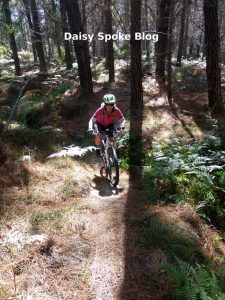 was missing it.
was missing it. 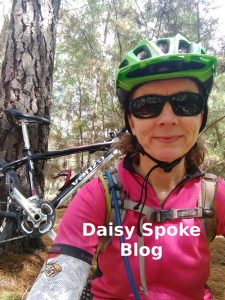 I’ve been practising and teaching this technique for a lot of years, and yet still I sometimes forget to do it when the moment arises. The thing is that on Sunday morning I DID NOTICE those fearful thoughts bouncing round my head. And guess what?
I’ve been practising and teaching this technique for a lot of years, and yet still I sometimes forget to do it when the moment arises. The thing is that on Sunday morning I DID NOTICE those fearful thoughts bouncing round my head. And guess what? 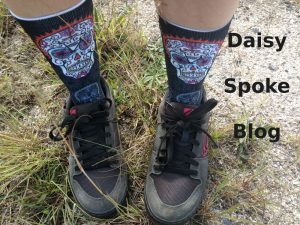 of short hills engaging my quads in an exertion that a couple of years ago would have been painful (if not impossible)! I pedalled in a higher gear than normal and found it easier than expected.
of short hills engaging my quads in an exertion that a couple of years ago would have been painful (if not impossible)! I pedalled in a higher gear than normal and found it easier than expected. 
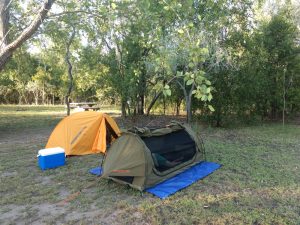 before we even set up camp we had a short walk around the area. A sudden loud rustle in the bushes next to us startled me. Turning around and expecting to see a wallaby, my daughter tells me I wouldn’t want to know what made that noise. On further enquiry she tells me it was a rather large snake, and I began to seriously wonder about moving our campsite further away from said snake.
before we even set up camp we had a short walk around the area. A sudden loud rustle in the bushes next to us startled me. Turning around and expecting to see a wallaby, my daughter tells me I wouldn’t want to know what made that noise. On further enquiry she tells me it was a rather large snake, and I began to seriously wonder about moving our campsite further away from said snake. My uneasiness only increased as the evening rolled on and in particular when we came face to face with another snake only a few metres from our tents. Still, I wandered why the uneasiness was there in the first place. Was I sensing a spiritual presence? Was it simply that everything seemed strange and unfamiliar? Or perhaps the absence of other humans? Was I simply tired and misreading my intuition? Was it FEAR welling up and testing my inner strength?
My uneasiness only increased as the evening rolled on and in particular when we came face to face with another snake only a few metres from our tents. Still, I wandered why the uneasiness was there in the first place. Was I sensing a spiritual presence? Was it simply that everything seemed strange and unfamiliar? Or perhaps the absence of other humans? Was I simply tired and misreading my intuition? Was it FEAR welling up and testing my inner strength?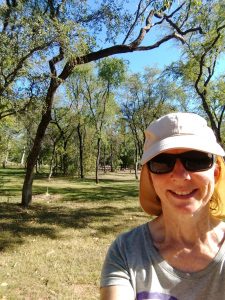 And so I survived. In fact I thrived and had possibly the best sleep so far on my April Adventure. I awoke before dawn, spent a couple of hours silently meditating, embracing my surroundings and feeling entirely captivated by what seemed so haunting and difficult the day before. I feel an immense sense of satisfaction that I didn’t allow my anxiety to rule and limit me. I chose to respect it but also to stand up to it. In doing so I’ve come to know an amazing spiritual aspect of this sacred land which I may not ever understand, but I can accept it and embrace it. And when I do that, I also accept and embrace myself.
And so I survived. In fact I thrived and had possibly the best sleep so far on my April Adventure. I awoke before dawn, spent a couple of hours silently meditating, embracing my surroundings and feeling entirely captivated by what seemed so haunting and difficult the day before. I feel an immense sense of satisfaction that I didn’t allow my anxiety to rule and limit me. I chose to respect it but also to stand up to it. In doing so I’ve come to know an amazing spiritual aspect of this sacred land which I may not ever understand, but I can accept it and embrace it. And when I do that, I also accept and embrace myself.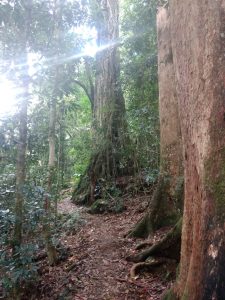 My Year of Adventure in fact began on New Year’s Eve as I set off on a week long road trip with my family to Melbourne and back home again traversing half the eastern side of Australia. With one daughter now settled in Victoria, I refocused my attention on developing new online programs and resources for women. I was thrilled to take my “February Adventure” to Hahndorf in South Australia to participate in and present at the Thriving Women 2018 conference. My “March Adventure” was closer to home with weekends and day trips to several magnificent National Parks, immersing myself in one of my great loves – bushwalking.
My Year of Adventure in fact began on New Year’s Eve as I set off on a week long road trip with my family to Melbourne and back home again traversing half the eastern side of Australia. With one daughter now settled in Victoria, I refocused my attention on developing new online programs and resources for women. I was thrilled to take my “February Adventure” to Hahndorf in South Australia to participate in and present at the Thriving Women 2018 conference. My “March Adventure” was closer to home with weekends and day trips to several magnificent National Parks, immersing myself in one of my great loves – bushwalking.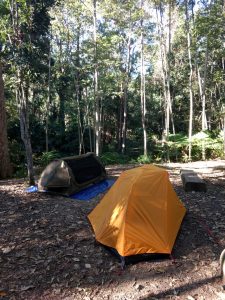 a lot of “what if’s” and identified as a fearful and hesitant adventurer rather than a brave one. My April Adventure has brought up a number of ‘firsts’ for me – I’ve left half my family behind, I’m travelling with only one companion (my younger daughter) through some fairly remote parts of Australia, I’m camping in a tent by myself, I’m having to step up and make decisions I’ve not been responsible for previously, and I’m operating a business far from home and frequently without mobile reception or internet connection.
a lot of “what if’s” and identified as a fearful and hesitant adventurer rather than a brave one. My April Adventure has brought up a number of ‘firsts’ for me – I’ve left half my family behind, I’m travelling with only one companion (my younger daughter) through some fairly remote parts of Australia, I’m camping in a tent by myself, I’m having to step up and make decisions I’ve not been responsible for previously, and I’m operating a business far from home and frequently without mobile reception or internet connection.
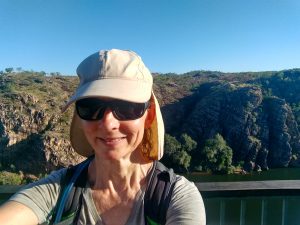
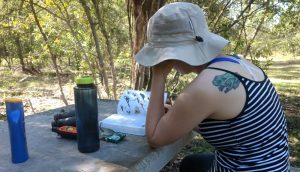
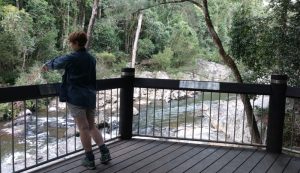



 Donna Neale-Arnold was my co-facilitator and special advisor at our recent retreat. She shared her w
Donna Neale-Arnold was my co-facilitator and special advisor at our recent retreat. She shared her w
 anything they want. It’s a message that’s intended to be encouraging by chipping away at the gender stereotypes our society has constructed over many generations. For so many reasons we know that women can, and do, achieve amazing things in our world. There are many wonderful role models who inspire and propel us towards our own version of success.
anything they want. It’s a message that’s intended to be encouraging by chipping away at the gender stereotypes our society has constructed over many generations. For so many reasons we know that women can, and do, achieve amazing things in our world. There are many wonderful role models who inspire and propel us towards our own version of success.  S
S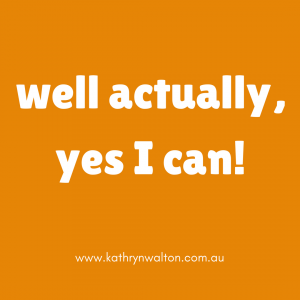 The beauty of the process is that you don’t have to even have any real idea of where you want your future to be heading in order to benefit from this retreat. Yo
The beauty of the process is that you don’t have to even have any real idea of where you want your future to be heading in order to benefit from this retreat. Yo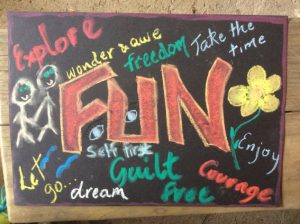 powerful creative activities. The gentle pace will support you to make valuable connections with
powerful creative activities. The gentle pace will support you to make valuable connections with  We will be giving away some special bonuses and door prizes at the retreat including beautiful journals, meditation cushions, carry bags, a Tony O’Connor CD of relaxation music, and more – fabulous gifts to support your self-care and progression!
We will be giving away some special bonuses and door prizes at the retreat including beautiful journals, meditation cushions, carry bags, a Tony O’Connor CD of relaxation music, and more – fabulous gifts to support your self-care and progression!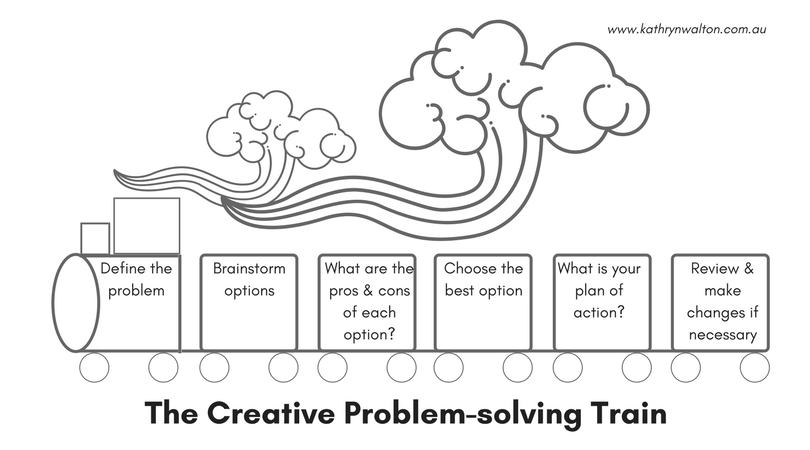
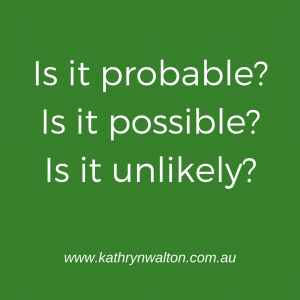 The Carriages (or steps, if you prefer!)
The Carriages (or steps, if you prefer!) analysing
analysing  5. Write down your Plan of Action so that you have a clear and concise guide to implementing your selected option.
5. Write down your Plan of Action so that you have a clear and concise guide to implementing your selected option. make the best ‘recipe’ for resilience and happiness – our world is full of distractions and quick-fix ideas. So, here I’d like to offer you some of the action-based ingredients that stand out through the ages and in all parts of world, and that are now backed up by rigorous research. In the next blog I’ll outline some of the very powerful mind-based strategies you can add to your mix to really step into your strength.
make the best ‘recipe’ for resilience and happiness – our world is full of distractions and quick-fix ideas. So, here I’d like to offer you some of the action-based ingredients that stand out through the ages and in all parts of world, and that are now backed up by rigorous research. In the next blog I’ll outline some of the very powerful mind-based strategies you can add to your mix to really step into your strength.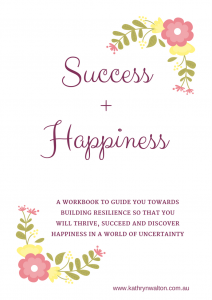 I have an EXCITING OFFER for you!
I have an EXCITING OFFER for you!